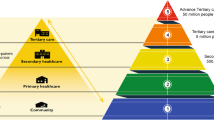Abstract
Two cataract-free-zone projects, one in Brazil and the other in Peru, were designed to provide surgery to all those who need and want it within a defined geographic area. In-home visual acuity screening was accepted by three-fourths of the enumerated population aged 50 years or more. Those with reduced bilateral visual acuity were referred to a community health post for ophthalmic examination. Among those diagnosed as bilaterally blind (≤20/200), comprising 5% of the screened population, two-thirds were thought to be blind from cataract. Because of other ocular pathology and general health conditions, surgery was not indicated for 30–50%. Two-thirds of those recommended for out-patient surgery accepted. Motivational efforts to convince the refusers were uniformly unsuccessful. The average age of those accepting and those refusing surgery was in the mid-seventies. Those already aphakic were 7–8 years younger. Post-operative acuity was ≥20/50 for only one-half of those operated. A significant number of cases had previously undetected macular degeneration and other causes of decreased vision. These projects have given increased attention to cataract blindness and the need for further operational research to develop effective methods for its control using outpatient surgery.
Similar content being viewed by others
References
Maitchouk IF. Data on Blindness. Vision 1982; 1: 99–113.
Ellwein LB, Kupfer C. Operations research in cataract blindness prevention. In: International Agency for the Prevention of Blindness, World Blindness and Its Prevention. Oxford: Oxford University Press, 1988; 58–69.
To Restore Sight: The Global Conquest of Cataract Blindness. New York: Helen Keller International, 1986.
Proposal for cataract-free zones in Latin America. In: International Agency for the Prevention of Blindness, World Blindness and Its Prevention. Oxford: Oxford University Press, 1988; 132–50.
Jose NK, Brazil Cataract-Free Zone Research Group. A population-based study to eliminate cataracts in a slum area in Campinas, Brazil. Invest Ophthal Vis Sci 1988; 29: 361.
Contreras F, Campos M, Peru Cataract-Free Zone Research Group. A population-based study to eliminate cataracts in Chimbote, Peru. Invest Ophthal Vis Sci 1988; 29: 361.
Brilliant GE. The Epidemiology of Blindness in Nepal. Chelsea, MI: The Seva Foundation, 1988; p 176.
Author information
Authors and Affiliations
Rights and permissions
About this article
Cite this article
Jose, N.K., Contreras, F., Campos, M.A. et al. Screening and surgical intervention results from cataract-free-zone projects in Campinas, Brazil and Chimbote, Peru. Int Ophthalmol 14, 155–164 (1990). https://doi.org/10.1007/BF00158313
Accepted:
Issue Date:
DOI: https://doi.org/10.1007/BF00158313




